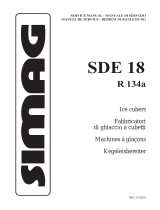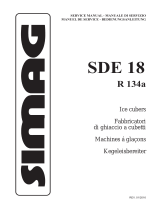12
When choosing the water supply for the N Cuber, con-
sideration should be given to:
A. Length of run.
B. Water clarity and purity.
C. Adequate water supply pressures.
Since water is the most important single ingredient in
producing ice you cannot over emphasize the three
items listed above. Low water pressure, below 1 bar
may cause malfunction, of the icemaker unit. Water
containing excessive minerals will tend to produce
cloudy colored ice cubes, plus scale build-up on parts
in the water system.
Heavily chlorinated water can be controlled using char-
coal or carbon filters.
DRAINS
AIR-COOLED MODELS: There is one 20 mm. dia
sump drain fitting at the back of the cabinet.
Insulations in high humidity areas is recommended.
The ideal drain receptacle would be a trapped and
vented floor drain.
WATER-COOLED MODELS: Besides the above drain,
a separate condenser drain must be run.
Connect it to the - 3/4'’ gas - condenser drain connec-
tion at the back of the cabinet.
STORAGE BIN: A separate gravity type drain needs to
be run, similar to the air-cooled sump drain. Insulation
of this drain line is recommended.
FOR THE ELECTRICIAN
ELECTRICAL CONNECTIONS
The unit come equipped with an electrical cord for
power supply. The lead wires must be connected to an
electrical plug that corresponds to the local electrical
codes and requirements or to a separate two poles
disconnect box with opening to the contacts of about 3
millimeters.
The disconnect box shoulds be placed close to the
selected ice maker location to be easily and prompt
reached.
Undersized wiring or unproperly installed electrical cir-
cuit will result in major problems and malfunctions.
Voltage variations shoud not exceed ten percent.
FINAL CHECK LIST
1. Is the cabinet/bin level?
2. Is the cuber in a location where ambient tempera-
tures are a minimum of 10°C (50-degrees F.) all
year around and to not exceed a maximum of
40°C. (100°F.).
3. Is there at least a 15 cm. clearance behind and
around the cabinet for all connections and for prop-
er air circulation?
4. Have all electrical and piping connections been
made?
5. Has the electrical power supply wiring been prop-
erly connected and the voltage tested and checked
against the nameplate rating? Has the unit proper-
ly grounded.
6. Is the water supply line shutoff valve installed and
opened and has the inlet water supply pressure
been checked to insure a minimum of 1 bar with-
out exceeding a maximum of 5 bar.
7. Have the compressor holddown bolts been
checked to be sure the compressor is snug on the
mounting pads.
8. Check all refrigerant lines and conduit lines to gard
against vibration and possible failure.
9. Has the cuber and the bin been wiped clean with
clean damp cloths?
10. Has the owner/user been given the User Manual
and instructed on how to operate the icemaker and
the importance of periodic maintenance?
11. Has the owner/user been given the name and tele-
phone number of the Authorized ICEMATIC
Distributor or Service Agency serving him?
12. Has the Manufacturer’s Registration Card been
properly filled out?
Check for correct Model and Serial Numbers from
nameplate, then mail the completed card to the
Manufactured.
NOTE: All ICEMATIC Cubers require a neutral
wire and a solid earth ground wire to prevent pos-
sible severe Electrical Shock Injury to individuals
or extensive damage to equipments.
IMPORTANT: All plumbing and electrical con-
nections must be made by licensed plumbers
and electricians, this one must follow the elec-
trical specifications printed on the ice maker
nameplate.






















